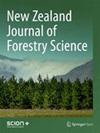Infection periods of Phytophthora pluvialis and Phytophthora kernoviae in relation to weather variables and season in Pinus radiata forests in New Zealand
IF 1.1
4区 农林科学
Q2 FORESTRY
引用次数: 1
Abstract
Background: Red needle cast caused by Phytophthora pluvialis Reeser, Sutton & E. Hansen, and less frequently P. kernoviae Brasier, Beales & S.A.Kirk, is an important foliar disease of Pinus radiata D.Don (radiata pine) in plantations throughout parts of New Zealand. Significant growth loss occurs following years when severe outbreaks occur. Aerial spraying with a copper-based fungicide has potential for disease control. Research is being carried out to optimise application timing, supported by complementary studies to understand RNC epidemiology. Methods: In order to determine the pathogen infection periods, a field trial was conducted over two years at two forests in the Central North Island of New Zealand. Batches of potted radiata pine seedlings were placed beneath diseased pine stands at fortnightly intervals, before returning them to an open nursery area for assessments of infection every two weeks (based on visual symptoms and qPCR) over a period of three months. A hybrid modelling approach was employed to establish relationships between the proportion of plants showing symptoms and weather conditions during the fortnight of exposure and previous fortnights. Gradient boosting machine learning analyses were used to identify the most important weather variables, followed by analysis of these by generalised mixed effects models, generalised least square models and ordinary least square models. Results: Development of RNC symptoms and detection of Phytophthora pluvialis and P. kernoviae on exchange seedlings was greatest for those exposed between April and September (Southern Hemisphere mid-autumn to early-spring). At this time, temperatures, solar radiation and evapotranspiration were lower, and rainfall and foliage wetness were plentiful. Modelling identified temperature and relative humidity several months before the date of exposure as the most important weather variables explaining infection. Conclusions: Because of autocorrelation, it was not possible to determine those variables that drive sporulation, dispersal, infection and symptom development. This will require more detailed exchange plant studies together with controlled environment inoculation experiments. Nevertheless, results of this and earlier work complement recent research indicating that it may be possible to manage RNC by fungicide applications made in late summer or autumn, early in the annual disease cycle.新西兰辐射松林雨疫霉和角疫霉侵染期与天气和季节的关系
背景:由雨疫病(Phytophthora pluvialis Reeser)、Sutton&E.Hansen和不太常见的P.kernoviae Brasier、Beales&S.A.Kirk引起的红针病是辐射松(Pinus radiata D.Don)在新西兰部分地区种植园中的一种重要的叶片病。严重疫情爆发后的几年会出现显著的生长损失。使用铜基杀菌剂进行空中喷洒具有控制疾病的潜力。在了解RNC流行病学的补充研究的支持下,正在进行研究以优化应用时机。方法:为了确定病原体的感染期,在新西兰中北岛的两个森林进行了为期两年的野外试验。每隔两周将一批批盆栽辐射松幼苗放置在患病的松树林下,然后在三个月内每两周将其送回开放的苗圃进行感染评估(基于视觉症状和qPCR)。采用混合建模方法来建立在暴露两周和前两周夜间出现症状的植物比例与天气条件之间的关系。梯度增强机器学习分析用于识别最重要的天气变量,然后通过广义混合效应模型、广义最小二乘模型和普通最小二乘模型对这些变量进行分析。结果:4月至9月(南半球仲秋至早春),交换苗RNC症状的发展以及雨疫霉和克氏疟原虫的检测最为严重。此时,气温、太阳辐射和蒸散量较低,降雨量和树叶湿度充足。模型确定,暴露日期前几个月的温度和相对湿度是解释感染的最重要的天气变量。结论:由于自相关,无法确定驱动孢子形成、扩散、感染和症状发展的变量。这将需要更详细的交换植物研究以及受控环境接种实验。尽管如此,这项和早期工作的结果补充了最近的研究,表明在夏末或秋季,即每年疾病周期的早期,可能通过施用杀菌剂来管理RNC。
本文章由计算机程序翻译,如有差异,请以英文原文为准。
求助全文
约1分钟内获得全文
求助全文
来源期刊

New Zealand Journal of Forestry Science
FORESTRY-
CiteScore
2.20
自引率
13.30%
发文量
20
审稿时长
39 weeks
期刊介绍:
The New Zealand Journal of Forestry Science is an international journal covering the breadth of forestry science. Planted forests are a particular focus but manuscripts on a wide range of forestry topics will also be considered. The journal''s scope covers forestry species, which are those capable of reaching at least five metres in height at maturity in the place they are located, but not grown or managed primarily for fruit or nut production.
 求助内容:
求助内容: 应助结果提醒方式:
应助结果提醒方式:


